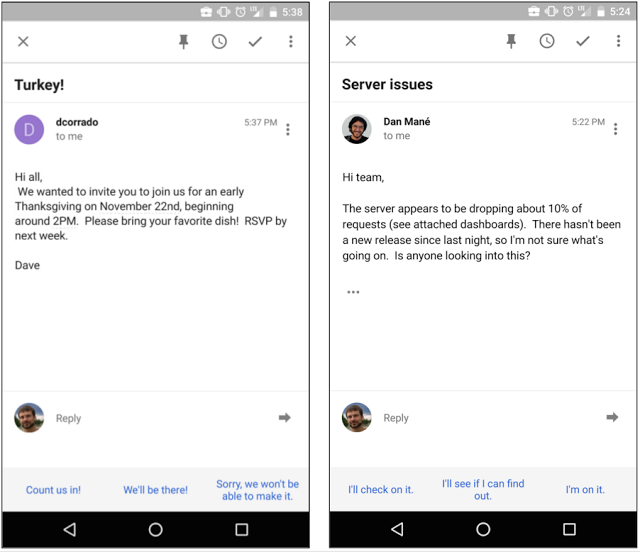Smart Reply: Google App that automatically responds to your emails launched

For all you people on the move, Google has made life a bit easier by launching a new feature called Smart Reply that provides a few automatic responses to emails. All you have to do is choose the most appropriate one and send. The Smart Reply feature will come up with an update for iOS and Android versions of Inbox later in the week.
Relying on deep neural networks mimicking the brain and learning by scanning many emails, Google's artificial intelligence software uses one network to scan and encode the inbox mail and another to predict and craft possible replies.
Writing in a research blog, Google scientist Greg Corrado writes how the task was challenging given the diversity with which real people communicate. But with experience in machine learning that detects spam and categorises email, the researchers knew it was not impossible.
Anjuli Kannan, a Google engineer experimented with the sequence-to-sequence ideas that have been used to power chatbots. The result was the industrial strength neural network behind the Smart Reply launched this week. The approach was to go for a machine-learned system, rather than one based on rules as they are able to generalize better.
The encoding network consumes the words of the incoming email one at a time, and produces a 'thought vector' that captures the gist of what is being said. The second network starts from this thought vector and synthesizes a grammatically correct reply one word at a time.
The networks do their tasks based on the learning. This machine learning is based on data that researchers cannot read, in order to adhere to privacy standards.
The three most likely responses turned out to be not so useful: "How about tomorrow?" "Wanna get together tomorrow?" "I suggest we meet tomorrow." The early prototype responded with a mushy "I love you" to any mail! Blame it on the most common responses the machine had picked up in its learning.
Another team improved the machine learning system by mapping natural language responses to semantic intents and coming up with better choices that have underlying meaning as well. The result was Smart Reply.
© Copyright IBTimes 2024. All rights reserved.





















